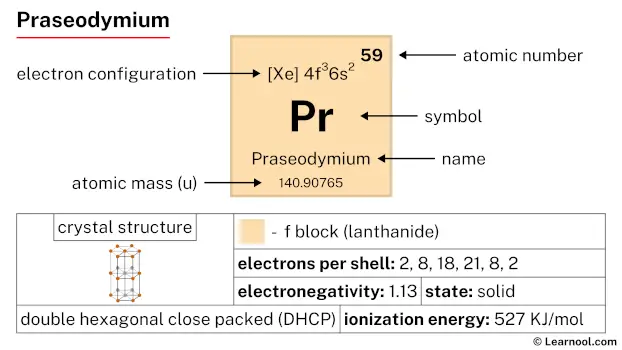
Praseodymium (Pr) is a chemical element of the periodic table, located in the period 6, and has the atomic number 59. It is the third element in the lanthanide series. It is a soft, malleable, ductile, grayish-white metal, whose name comes from the Greek word “prasios didymos”, which means green twin. It is counted as one of the rare earth elements.
On periodic table
| group | ⇨ | 1 | 2 | 3 | 4 | 5 | 6 | 7 | 8 | 9 | 10 | 11 | 12 | 13 | 14 | 15 | 16 | 17 | 18 |
| period | ⇩ | ||||||||||||||||||
| 1 | 1 H 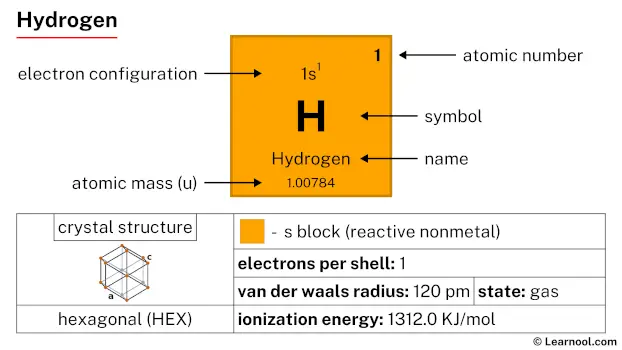 Hydrogen |
2 He  Helium |
|||||||||||||||||
| 2 | 3 Li  Lithium |
4 Be 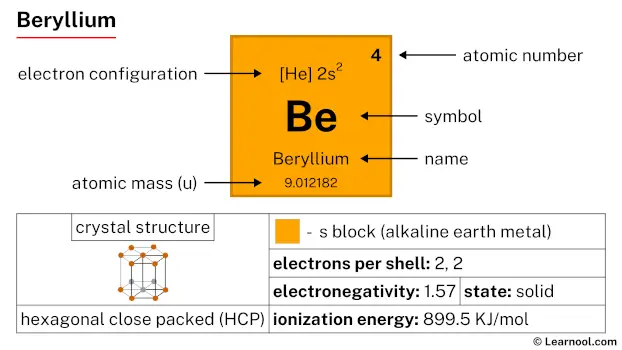 Beryllium |
5 B 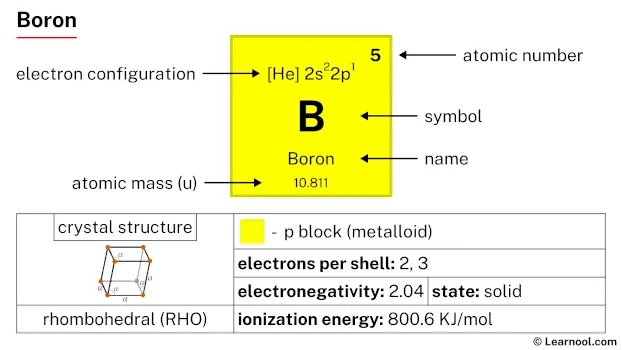 Boron |
6 C  Carbon |
7 N 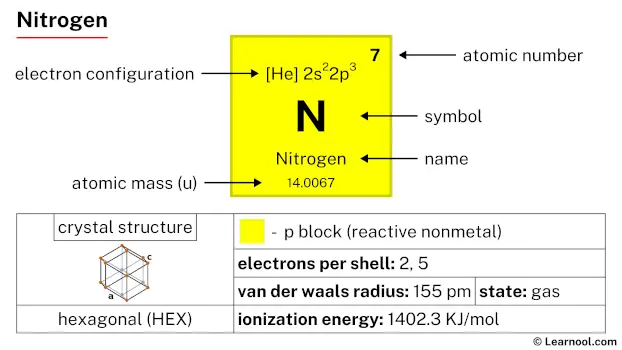 Nitrogen |
8 O 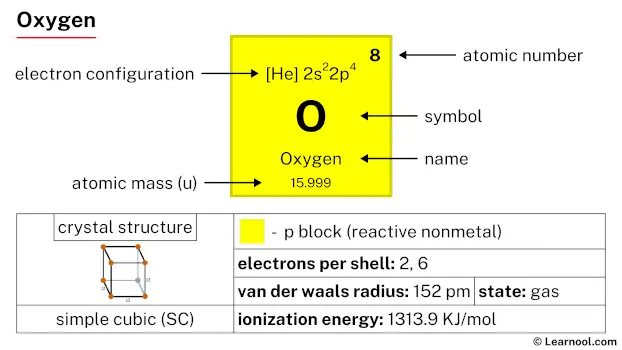 Oxygen |
9 F 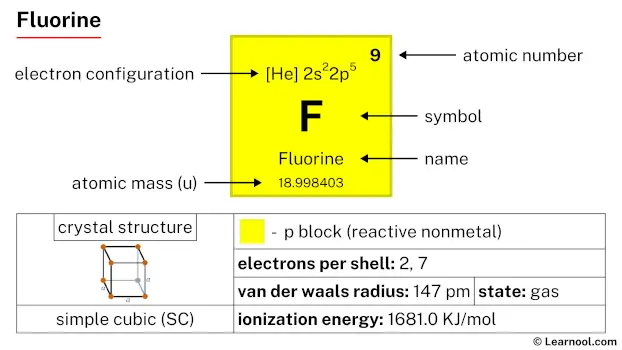 Fluorine |
10 Ne 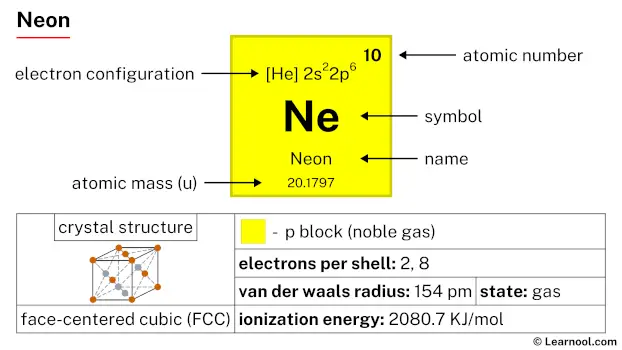 Neon |
|||||||||||
| 3 | 11 Na 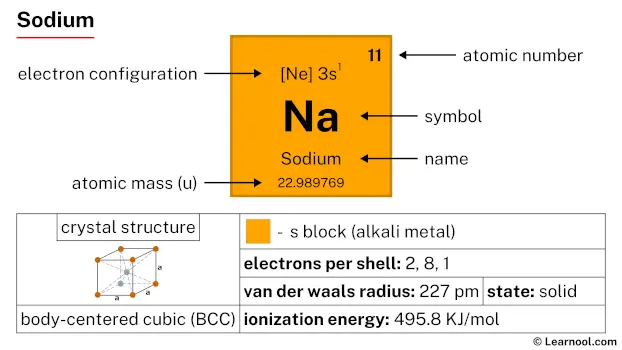 Sodium |
12 Mg 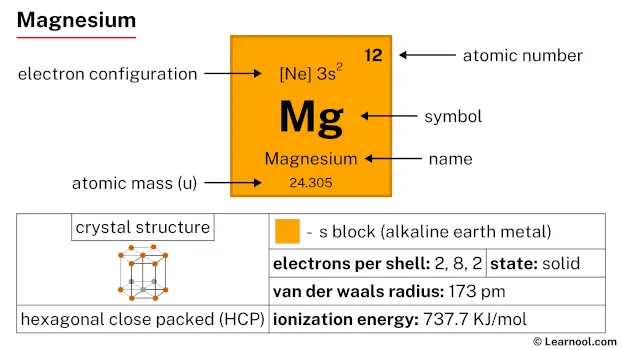 Magnesium |
13 Al  Aluminium |
14 Si Silicon |
15 P 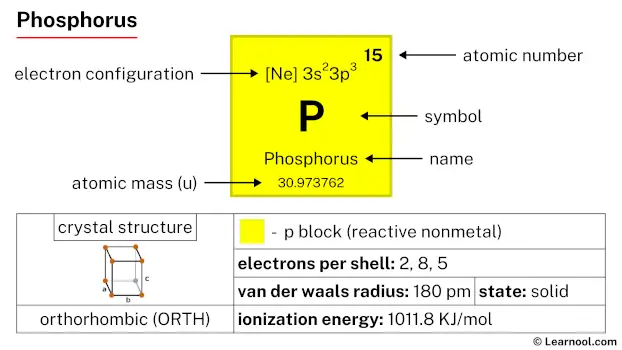 Phosphorus |
16 S 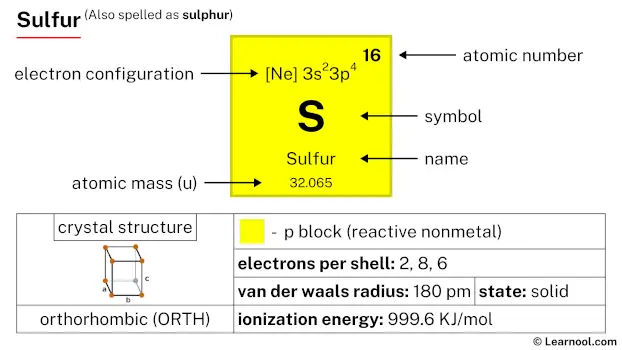 Sulfur |
17 Cl 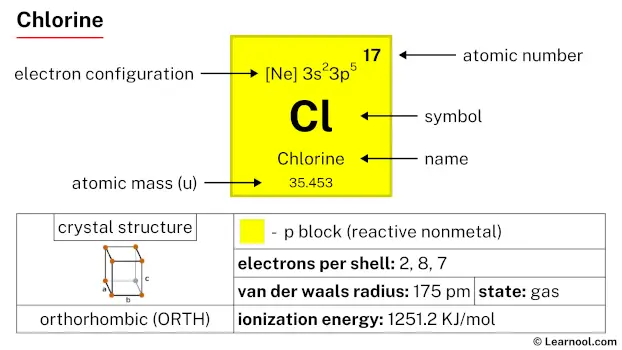 Chlorine |
18 Ar 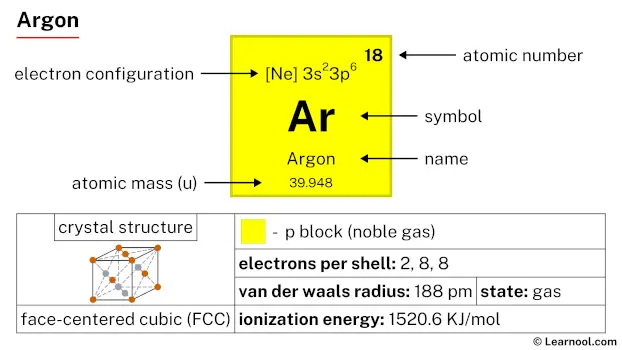 Argon |
|||||||||||
| 4 | 19 K 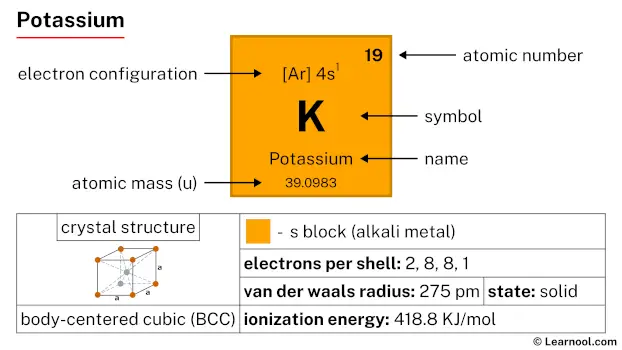 Potassium |
20 Ca 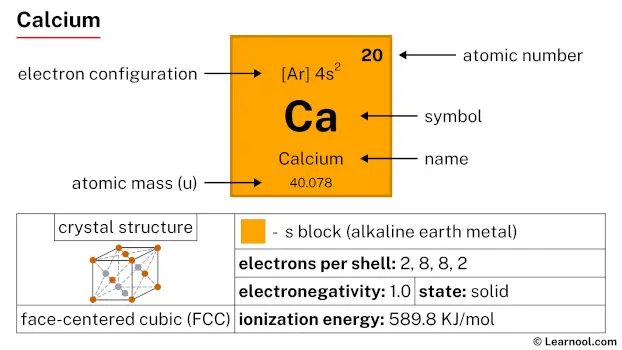 Calcium |
21 Sc 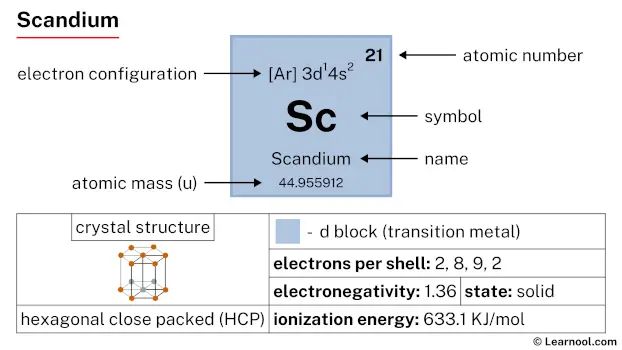 Scandium |
22 Ti 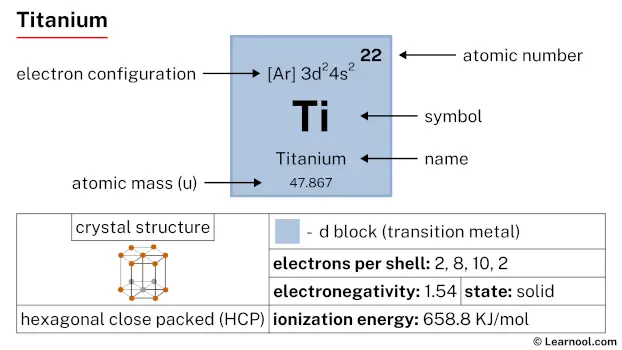 Titanium |
23 V 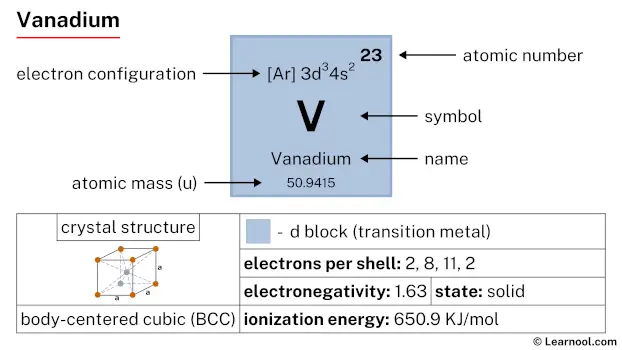 Vanadium |
24 Cr 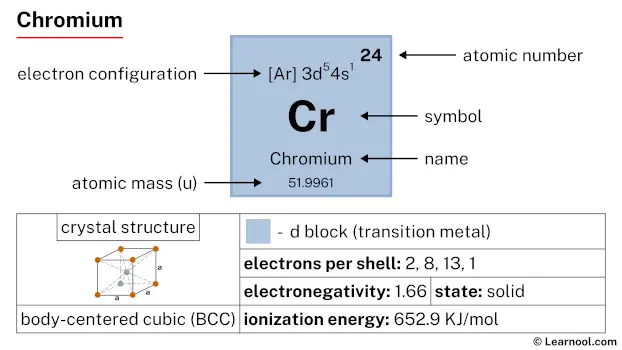 Chromium |
25 Mn 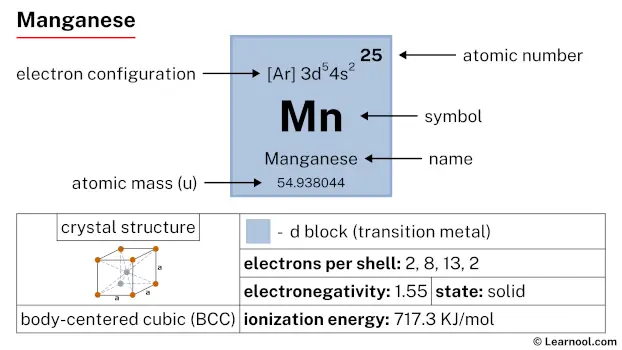 Manganese |
26 Fe 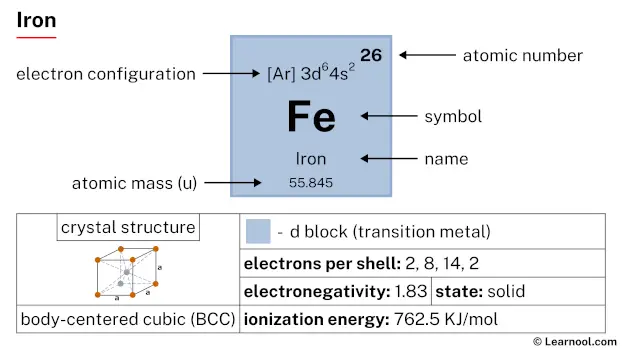 Iron |
27 Co 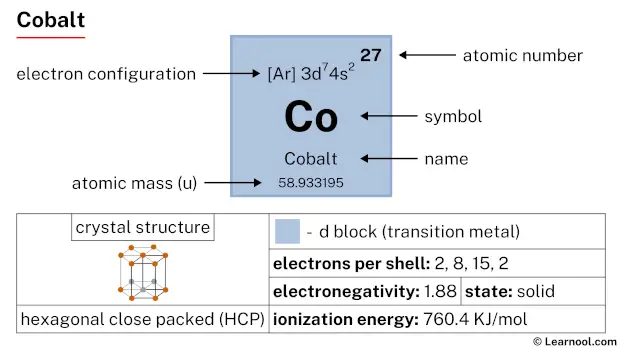 Cobalt |
28 Ni 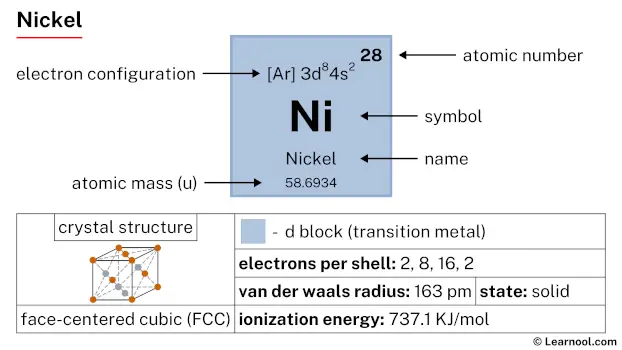 Nickel |
29 Cu 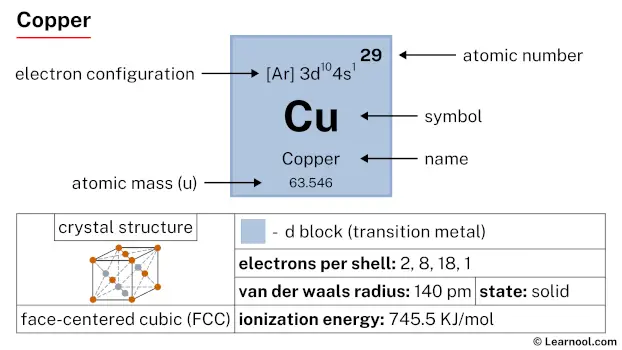 Copper |
30 Zn  Zinc |
31 Ga 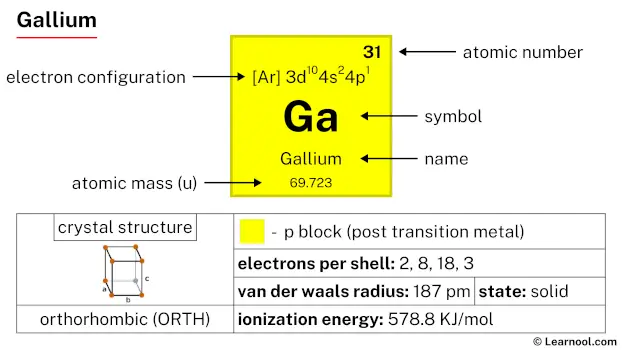 Gallium |
32 Ge 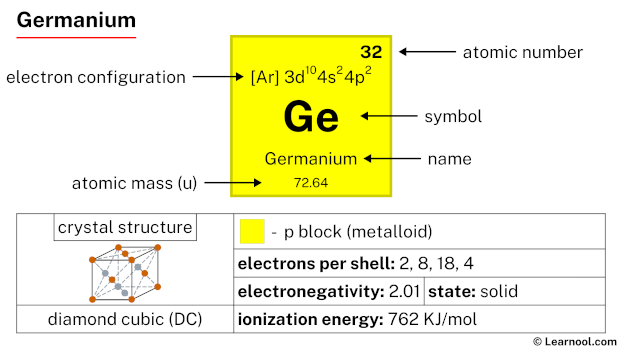 Germanium |
33 As 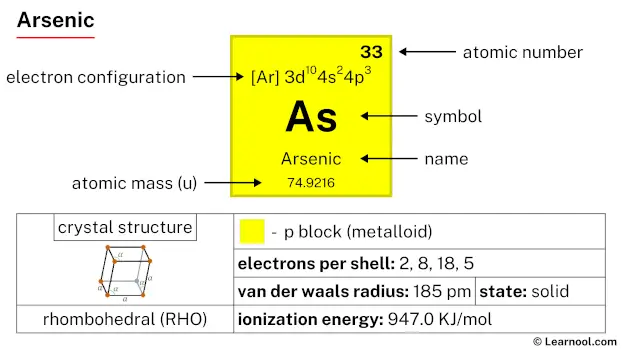 Arsenic |
34 Se 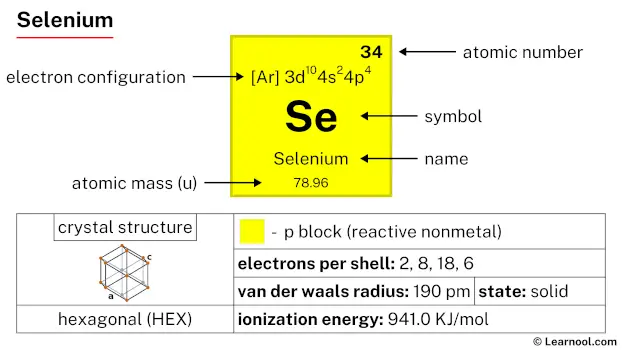 Selenium |
35 Br 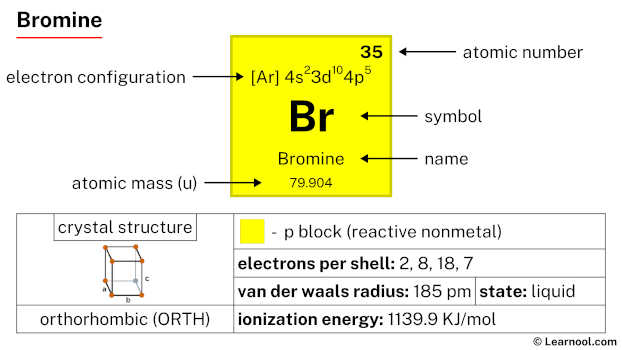 Bromine |
36 Kr  Krypton |
|
| 5 | 37 Rb 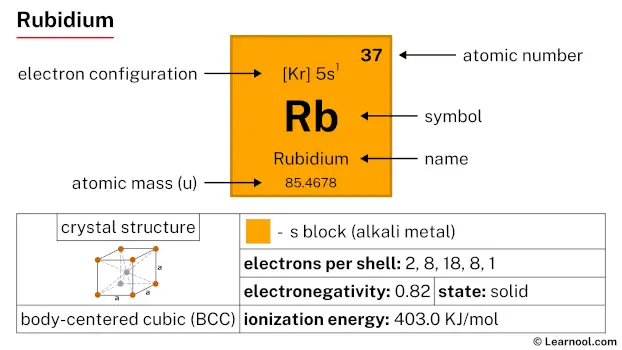 Rubidium |
38 Sr 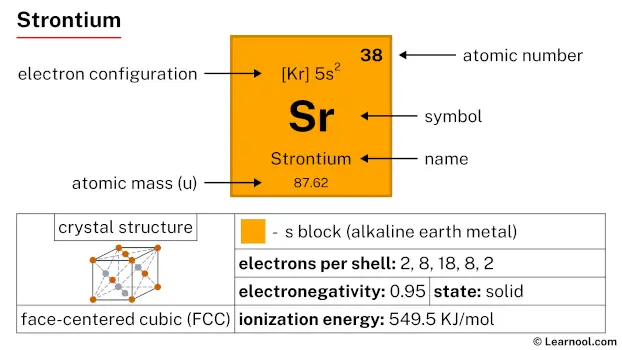 Strontium |
39 Y 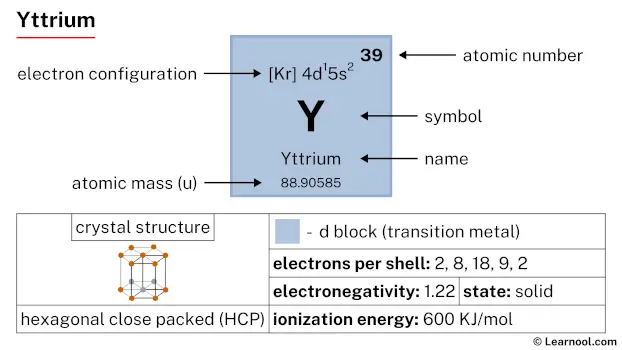 Yttrium |
40 Zr 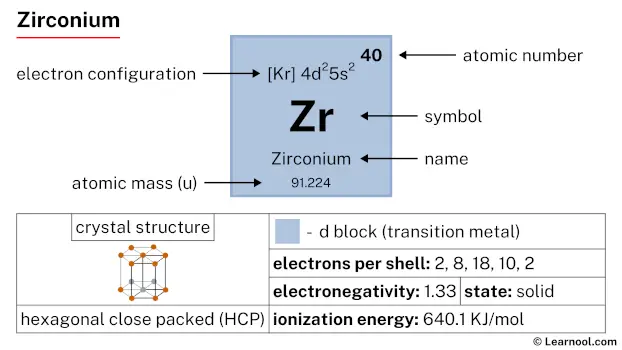 Zirconium |
41 Nb 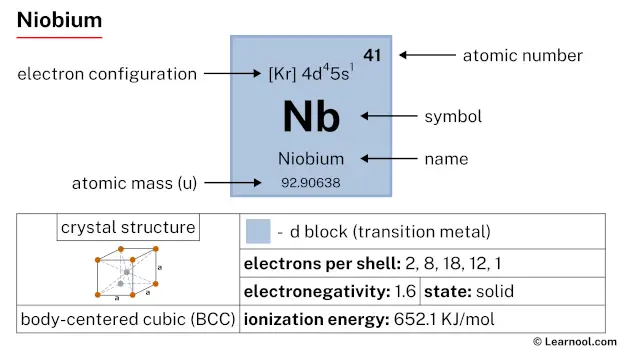 Niobium |
42 Mo 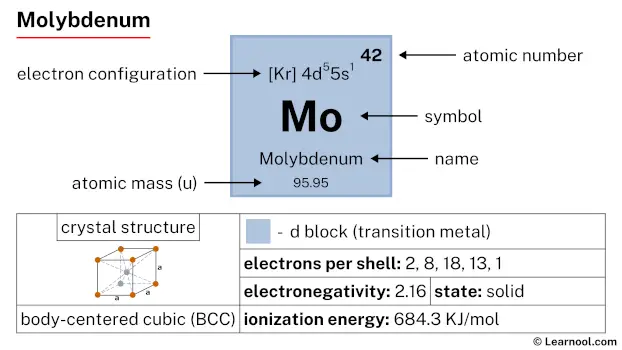 Molybdenum |
43 Tc 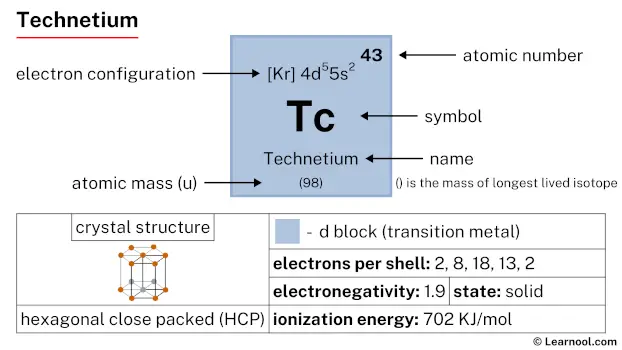 Technetium |
44 Ru 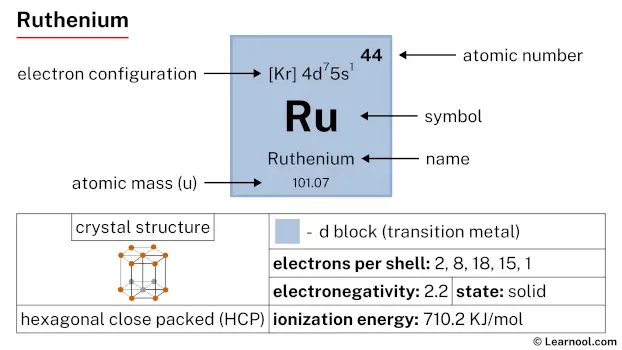 Ruthenium |
45 Rh 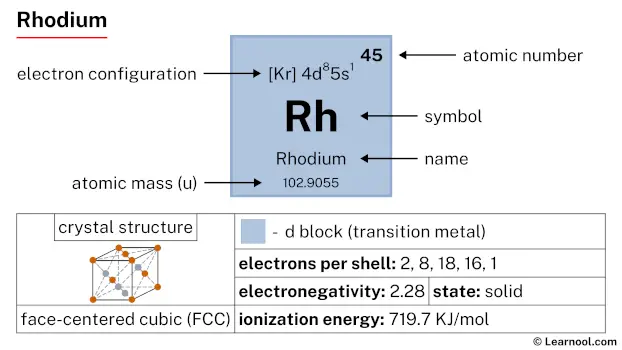 Rhodium |
46 Pd  Palladium |
47 Ag  Silver |
48 Cd 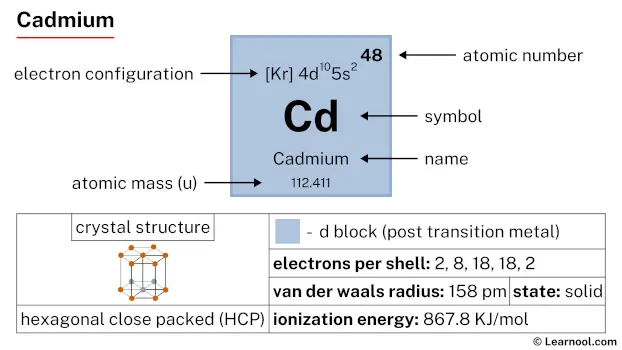 Cadmium |
49 In 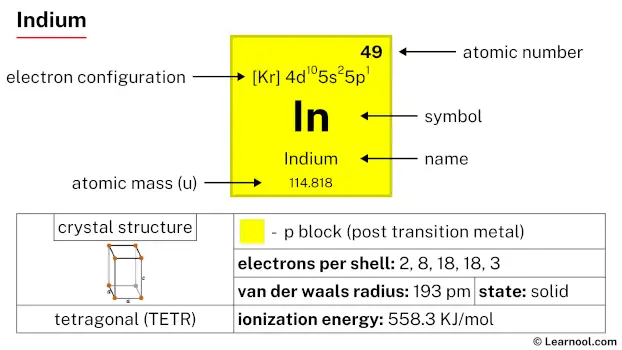 Indium |
50 Sn 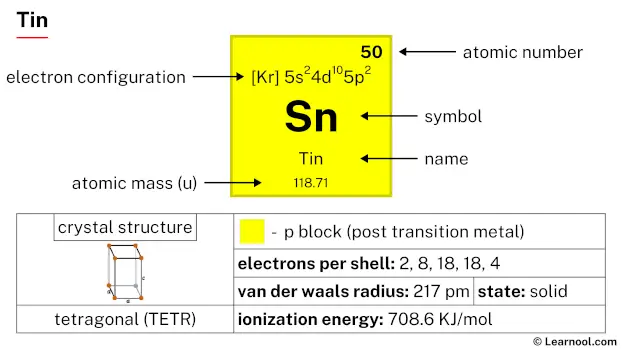 Tin |
51 Sb 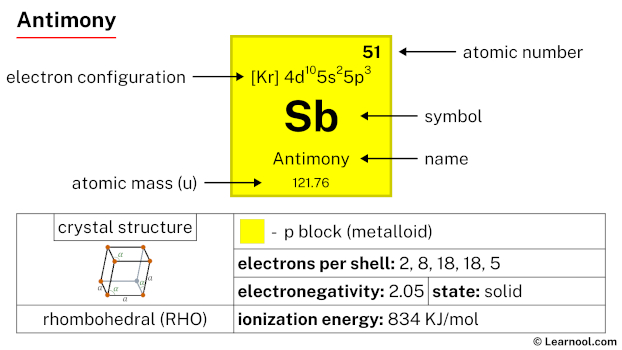 Antimony |
52 Te 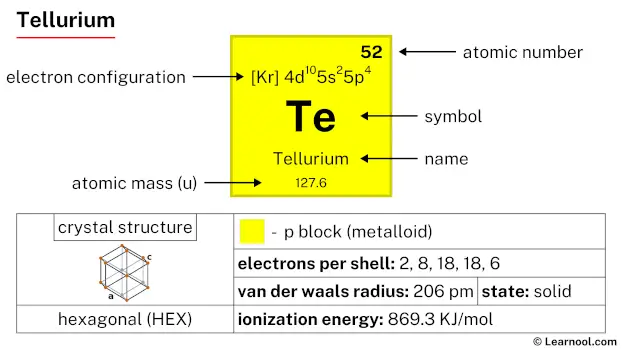 Tellurium |
53 I 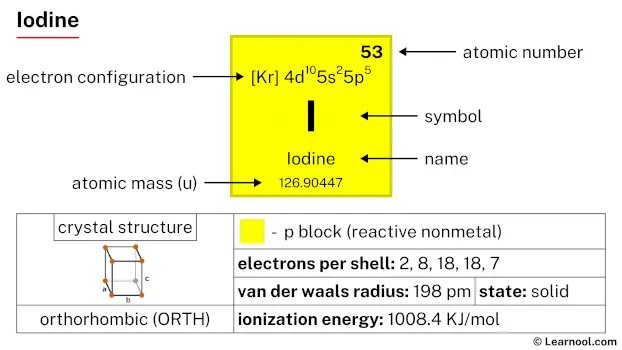 Iodine |
54 Xe 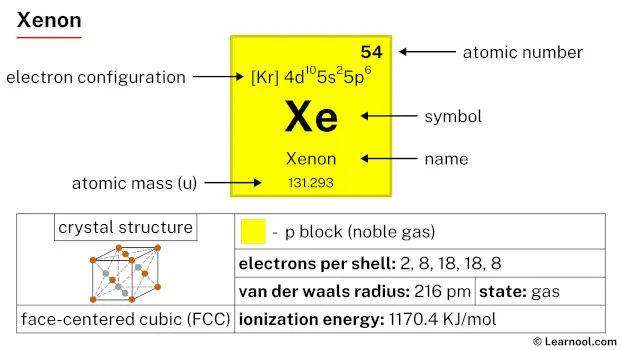 Xenon |
|
| 6 | 55 Cs 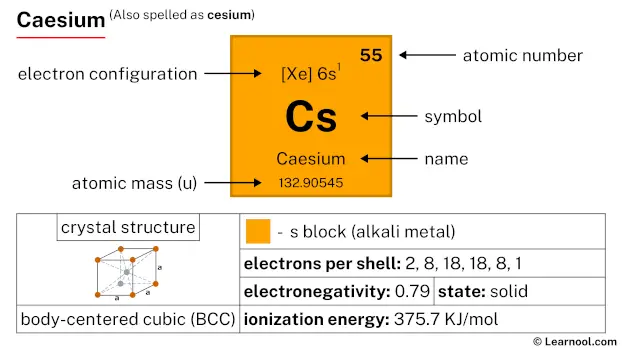 Caesium |
56 Ba 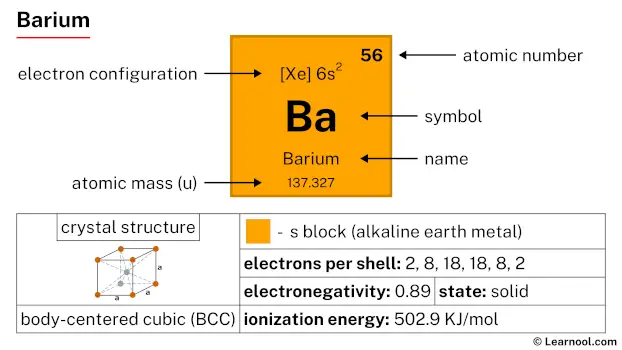 Barium |
72 Hf 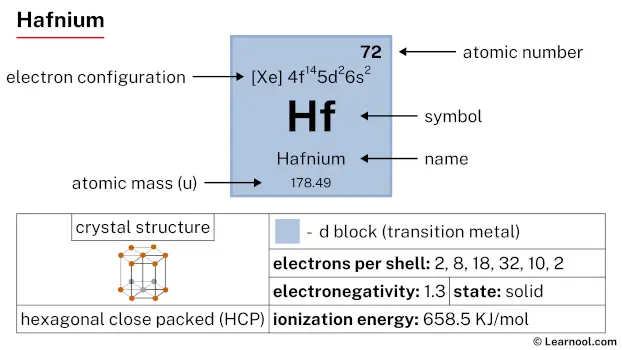 Hafnium |
73 Ta 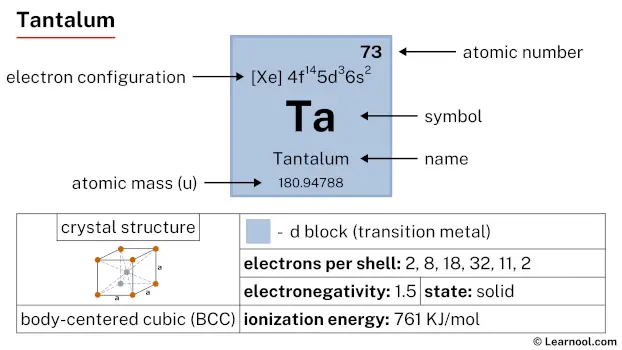 Tantalum |
74 W 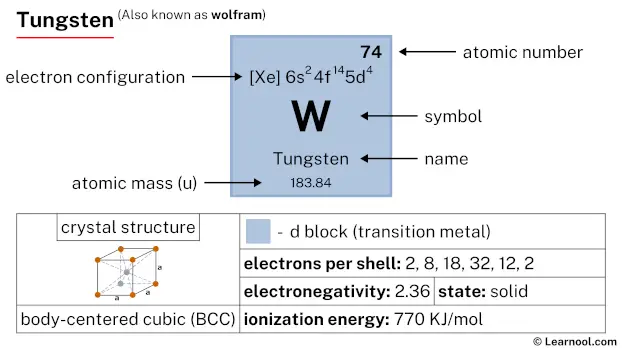 Tungsten |
75 Re 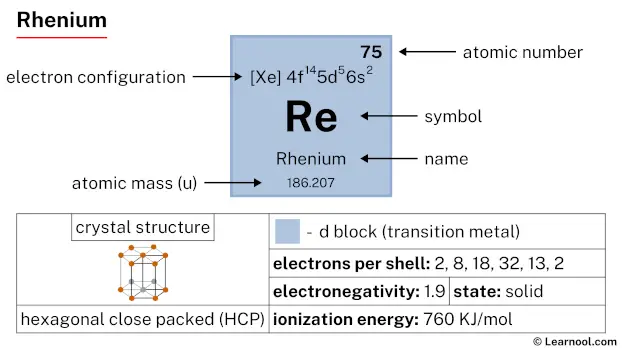 Rhenium |
76 Os 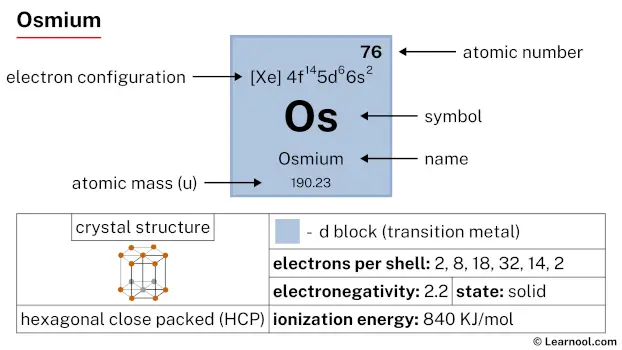 Osmium |
77 Ir 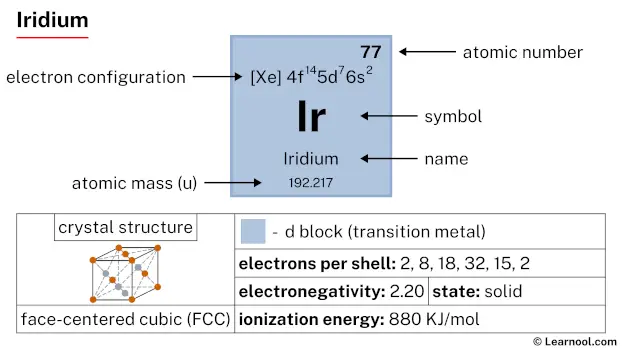 Iridium |
78 Pt  Platinum |
79 Au  Gold |
80 Hg 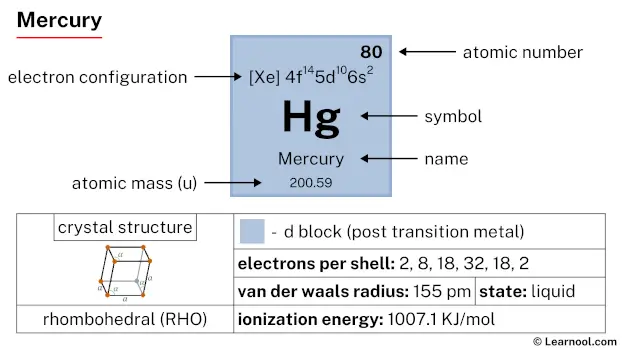 Mercury |
81 Tl 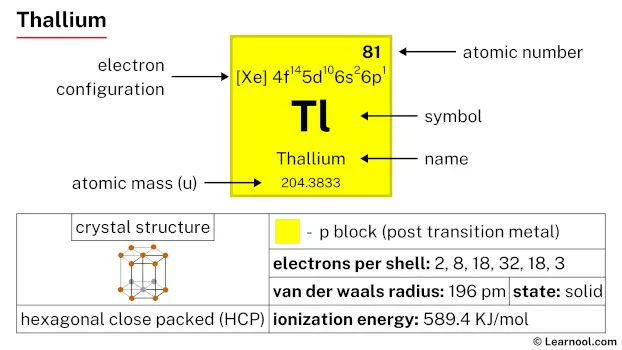 Thallium |
82 Pb  Lead |
83 Bi 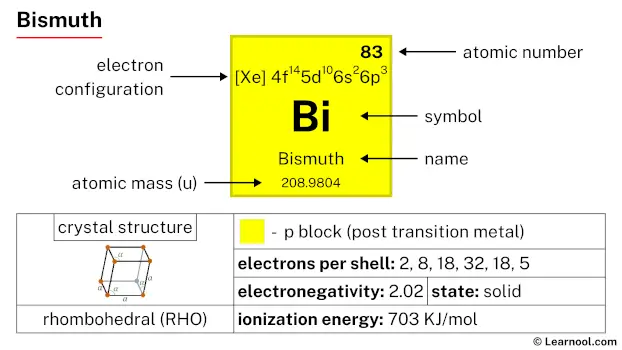 Bismuth |
84 Po 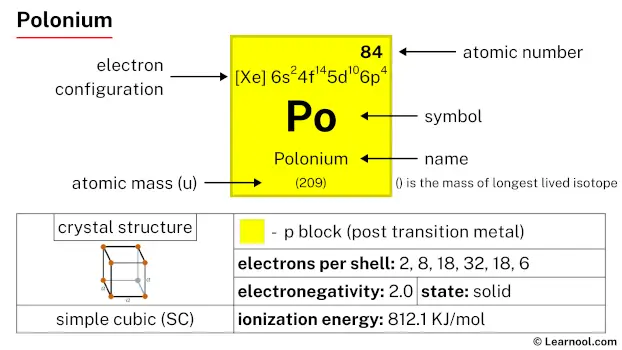 Polonium |
85 At 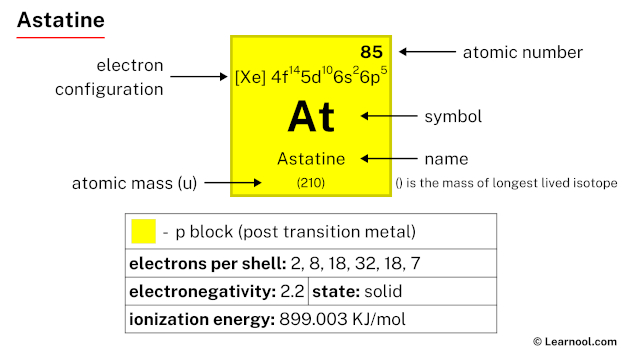 Astatine |
86 Rn 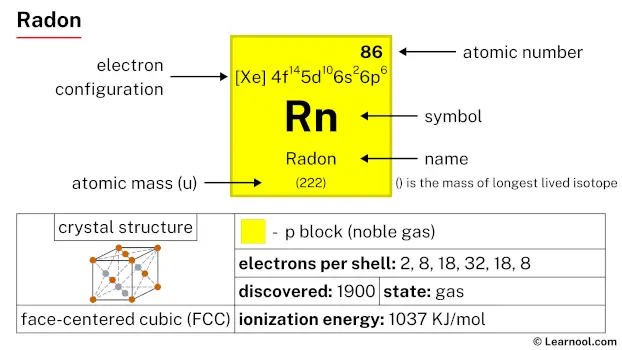 Radon |
||
| 7 | 87 Fr 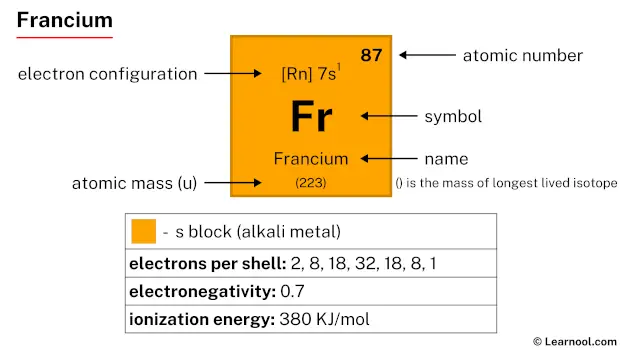 Francium |
88 Ra 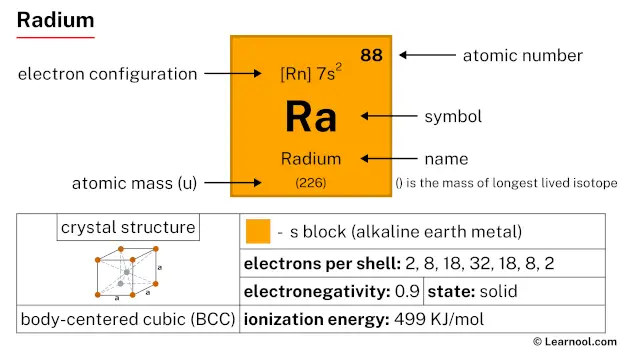 Radium |
104 Rf 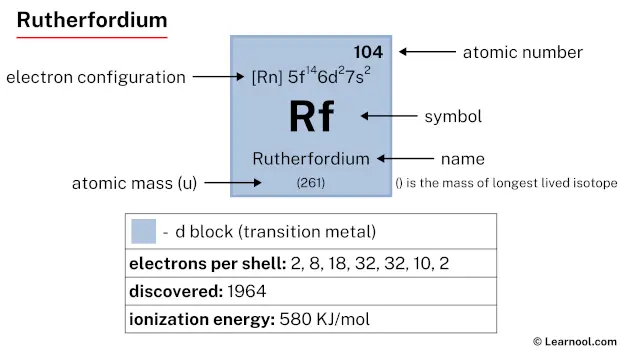 Rutherfordium |
105 Db 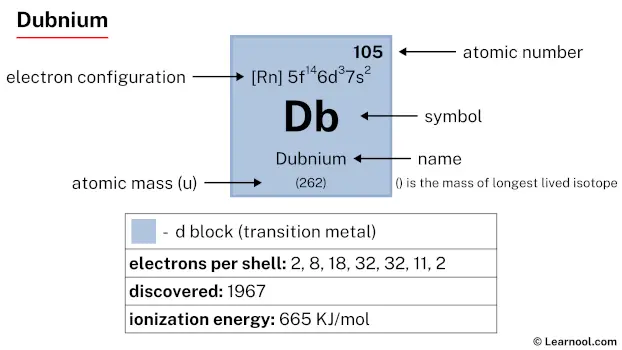 Dubnium |
106 Sg 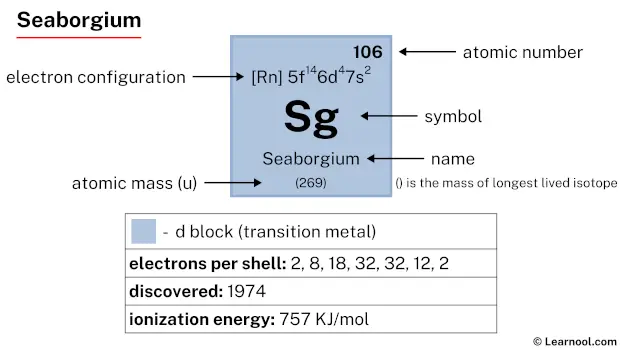 Seaborgium |
107 Bh 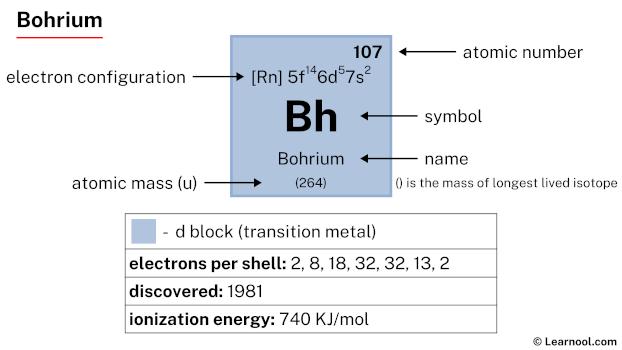 Bohrium |
108 Hs 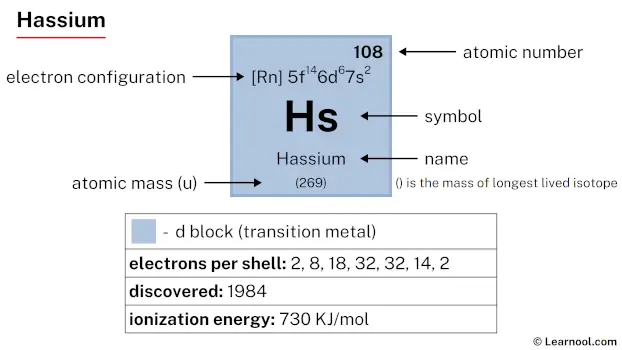 Hassium |
109 Mt 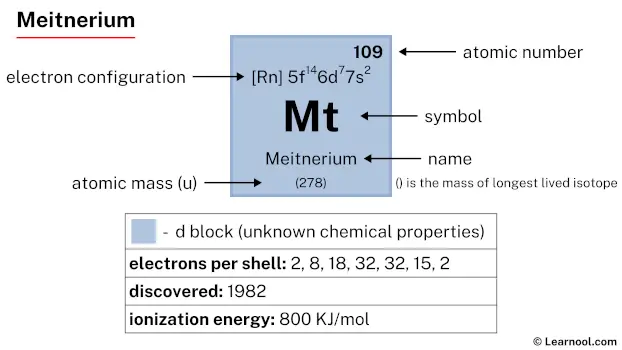 Meitnerium |
110 Ds 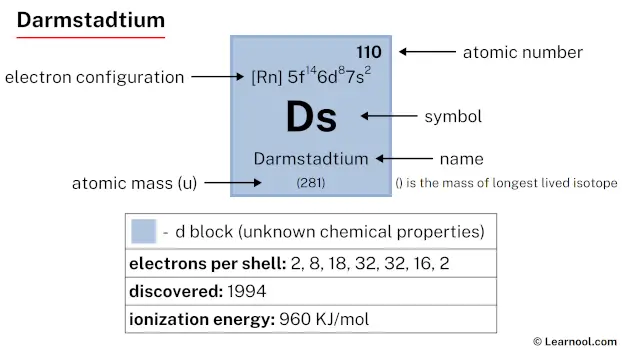 Darmstadtium |
111 Rg 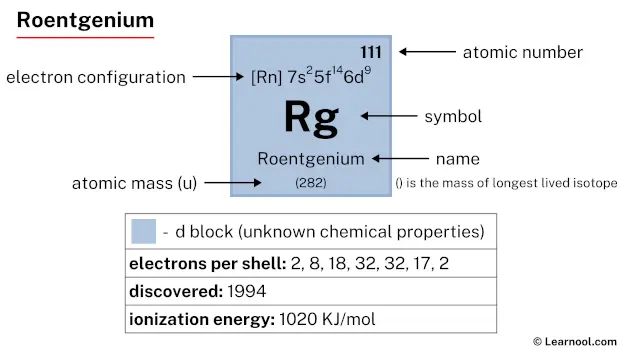 Roentgenium |
112 Cn  Copernicium |
113 Nh 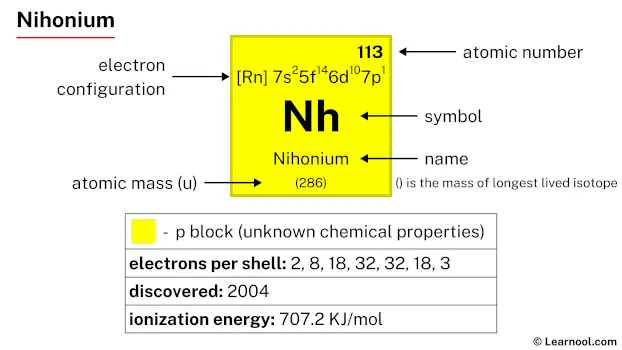 Nihonium |
114 Fl 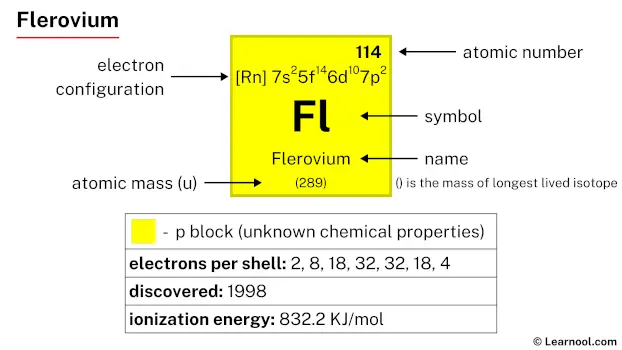 Flerovium |
115 Mc 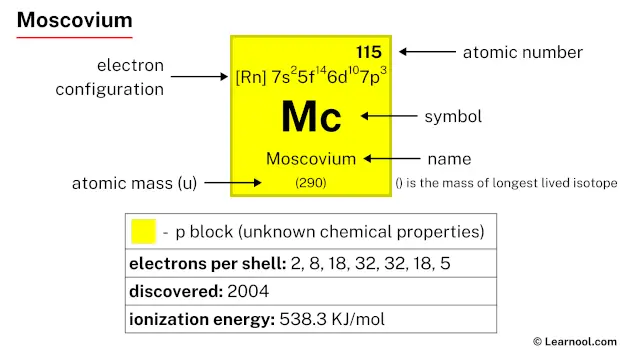 Moscovium |
116 Lv 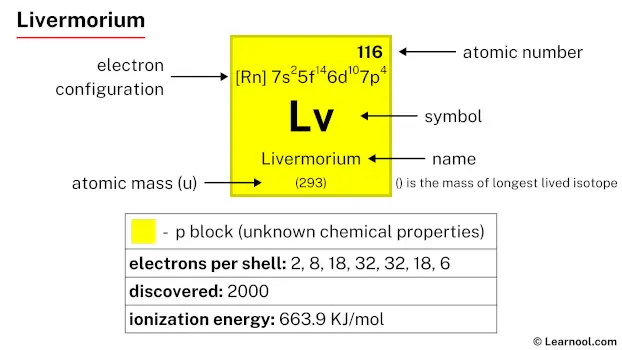 Livermorium |
117 Ts 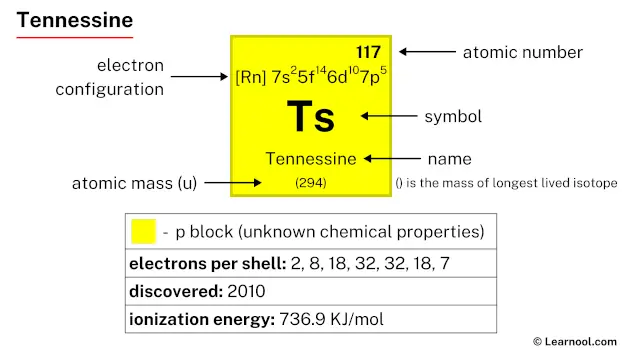 Tennessine |
118 Og 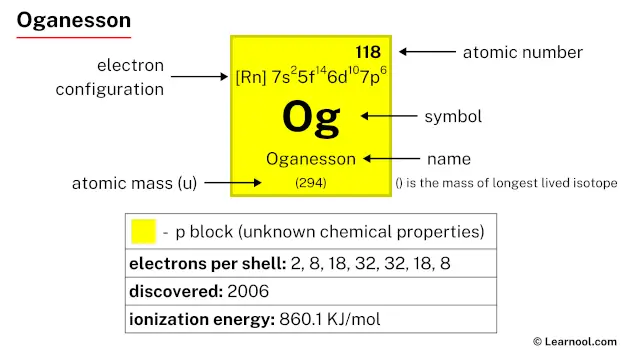 Oganesson |
||
| 57 La 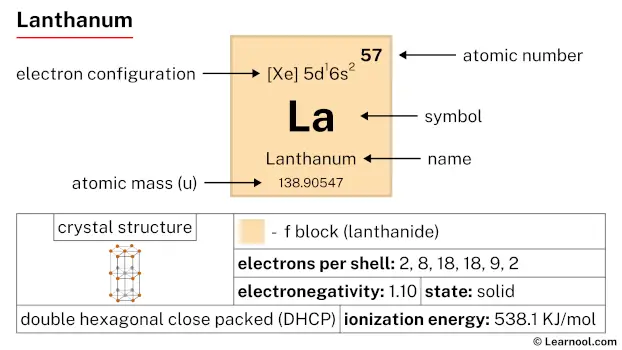 Lanthanum |
58 Ce 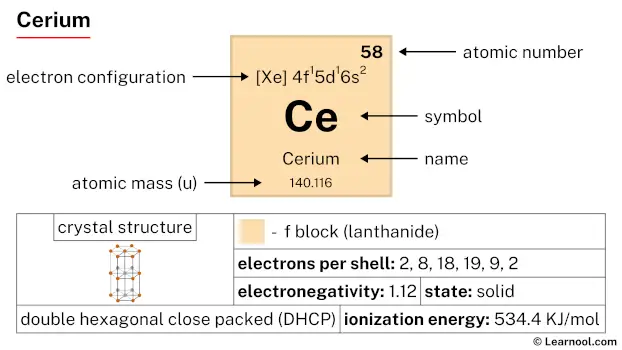 Cerium |
59 Pr Praseodymium |
60 Nd 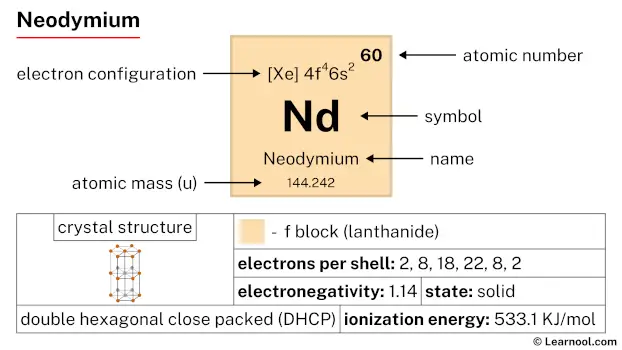 Neodymium |
61 Pm 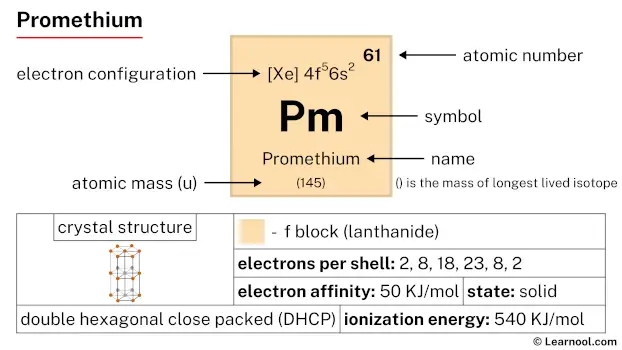 Promethium |
62 Sm 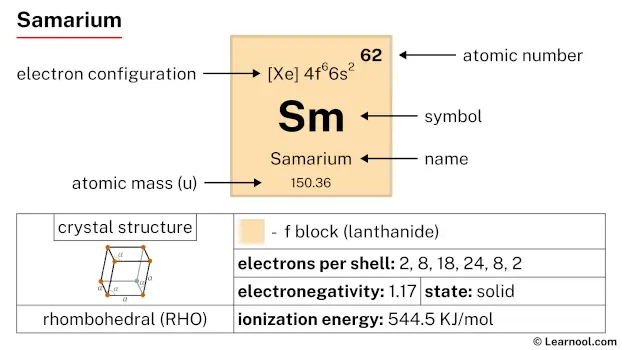 Samarium |
63 Eu 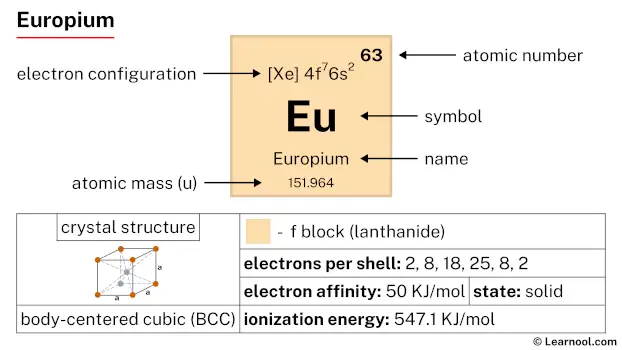 Europium |
64 Gd 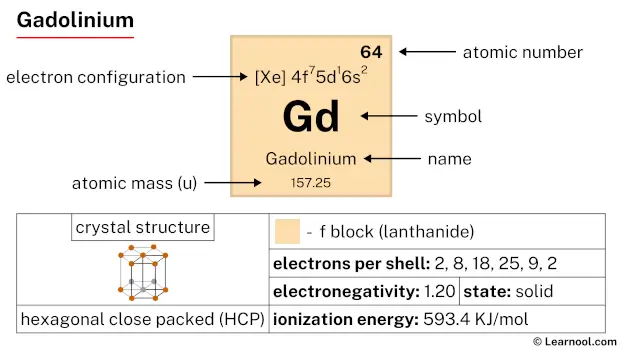 Gadolinium |
65 Tb 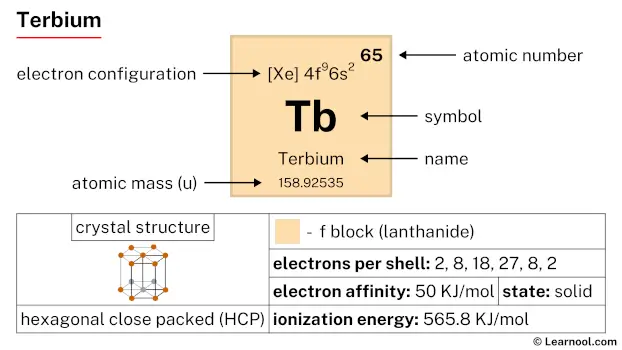 Terbium |
66 Dy 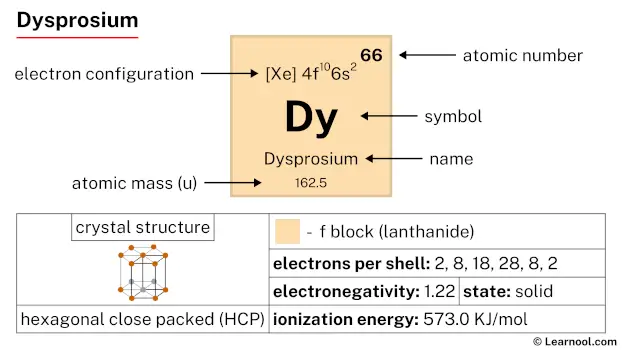 Dysprosium |
67 Ho 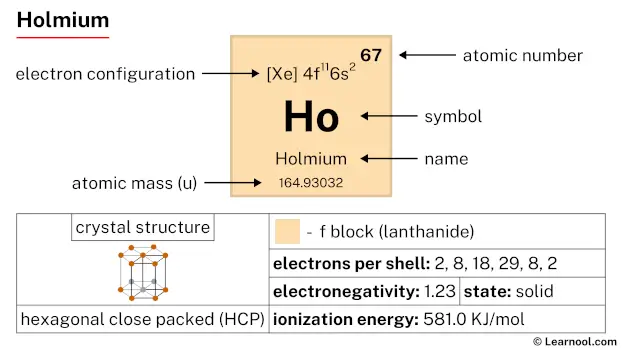 Holmium |
68 Er 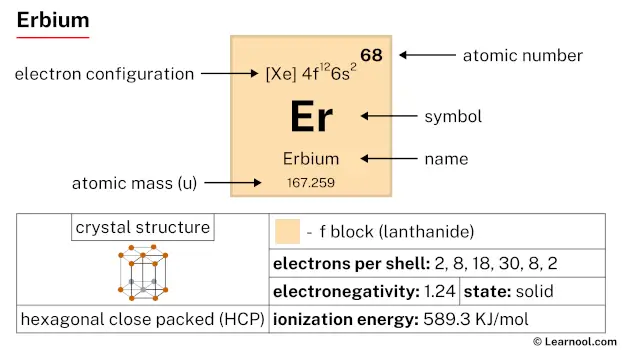 Erbium |
69 Tm 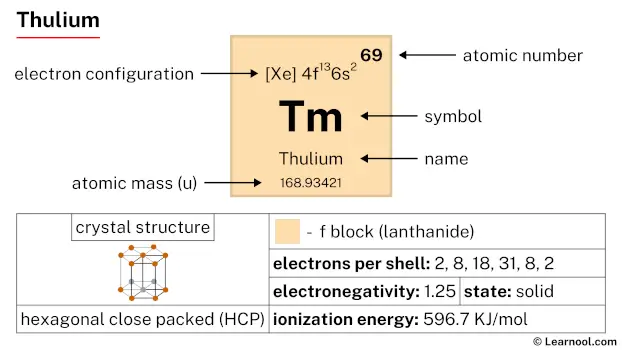 Thulium |
70 Yb 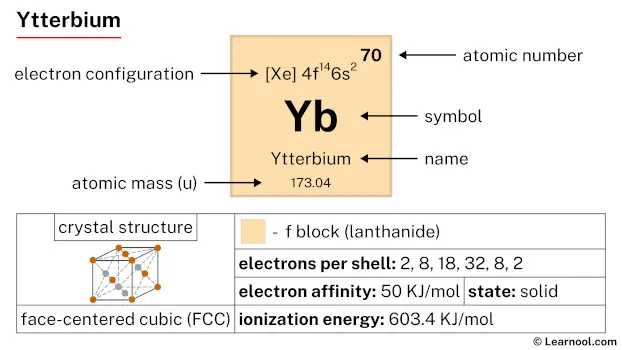 Ytterbium |
71 Lu 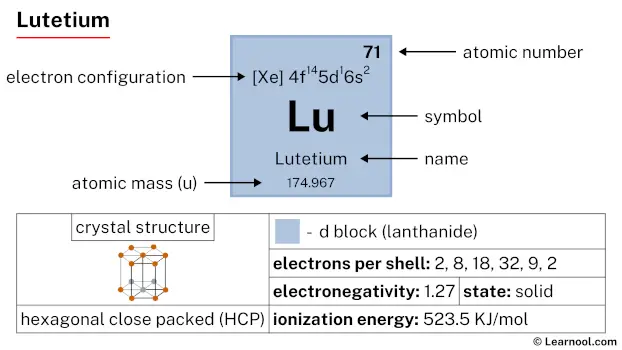 Lutetium |
|||||
| 89 Ac 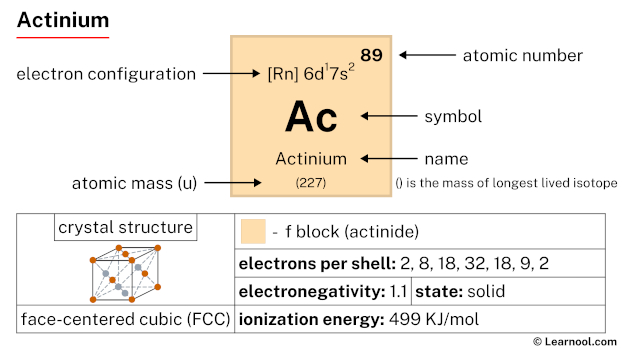 Actinium |
90 Th 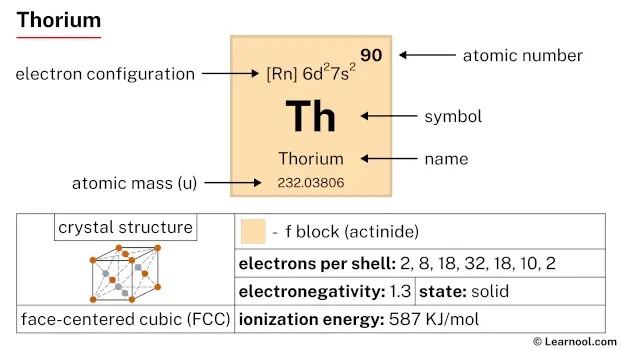 Thorium |
91 Pa 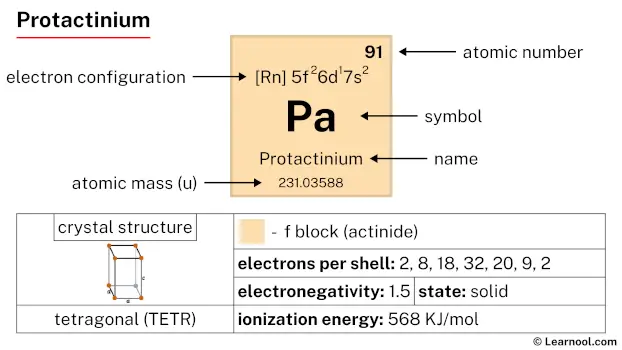 Protactinium |
92 U 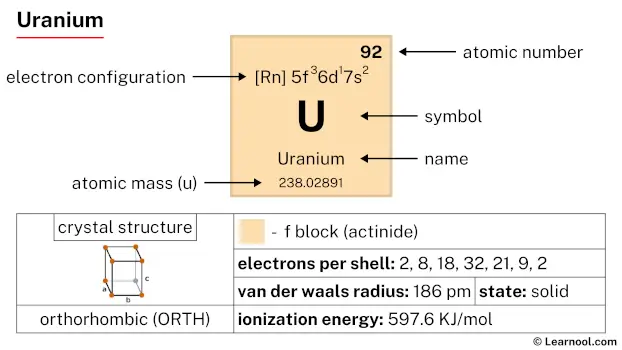 Uranium |
93 Np 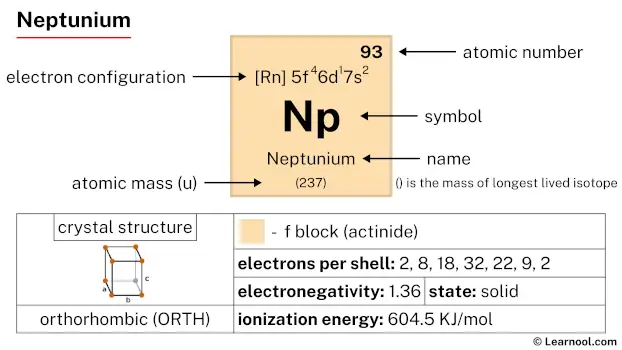 Neptunium |
94 Pu 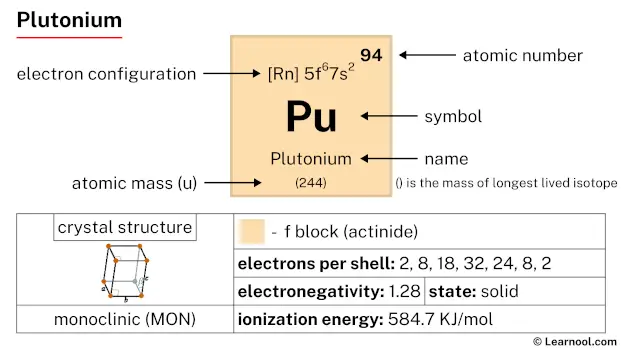 Plutonium |
95 Am  Americium |
96 Cm 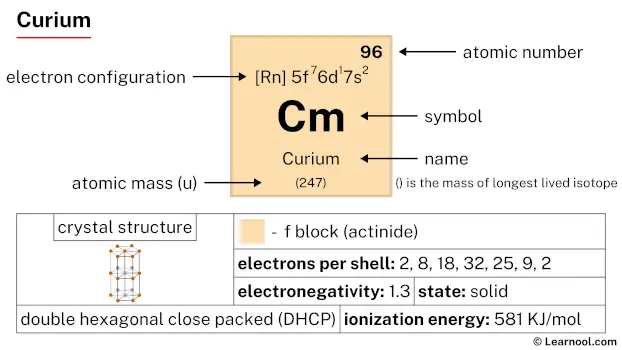 Curium |
97 Bk 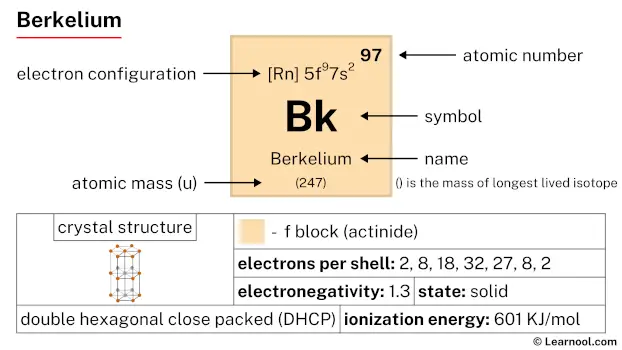 Berkelium |
98 Cf 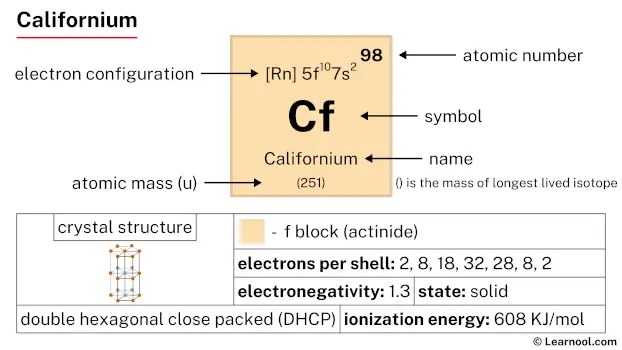 Californium |
99 Es 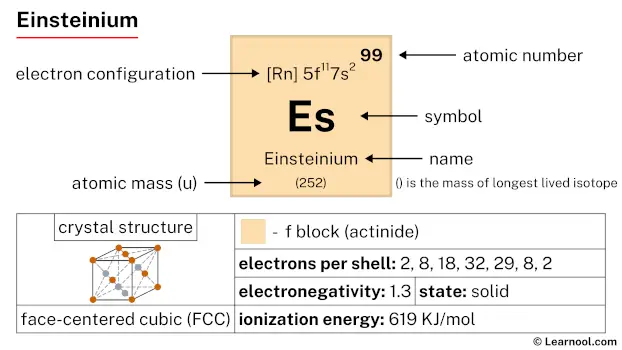 Einsteinium |
100 Fm 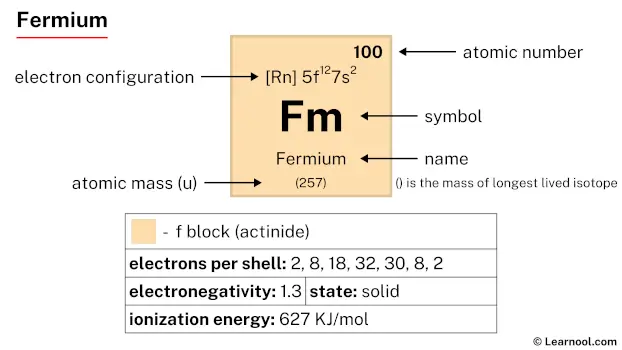 Fermium |
101 Md 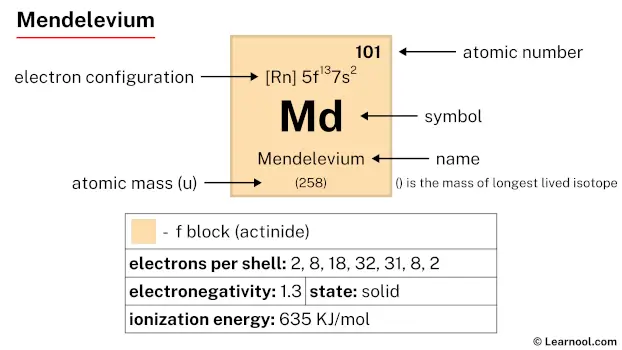 Mendelevium |
102 No 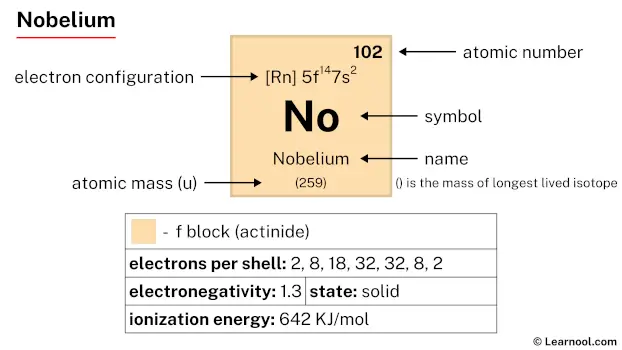 Nobelium |
103 Lr 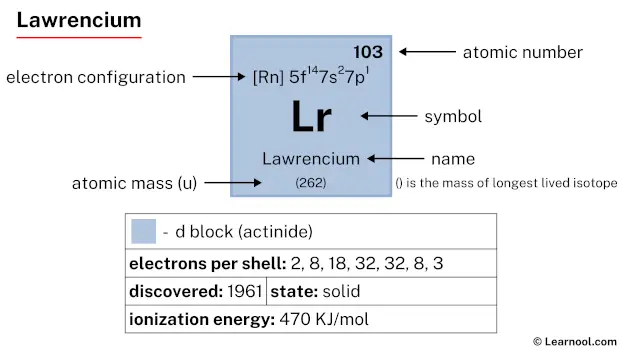 Lawrencium |
|||||
| – f block |
Praseodymium is found in the lanthanide series, a group of elements located at the bottom of the periodic table. Specifically, in period 6, between cerium (Ce) and neodymium (Nd).
Element information
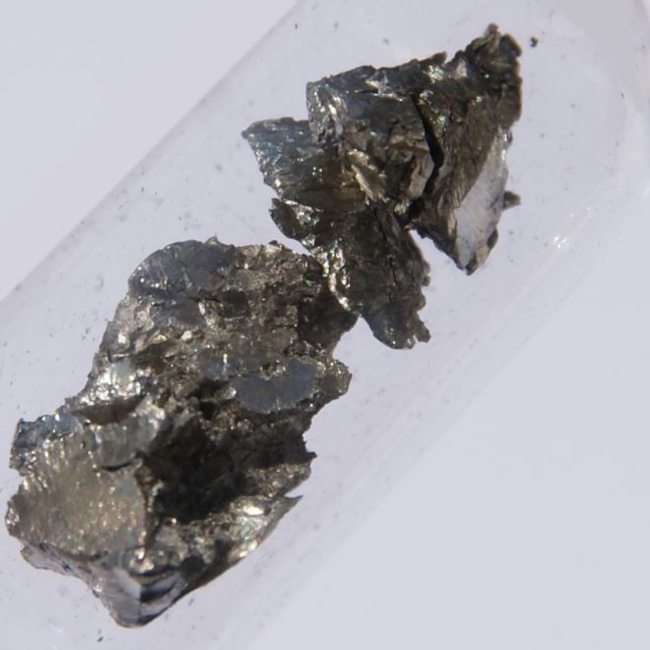 |
|
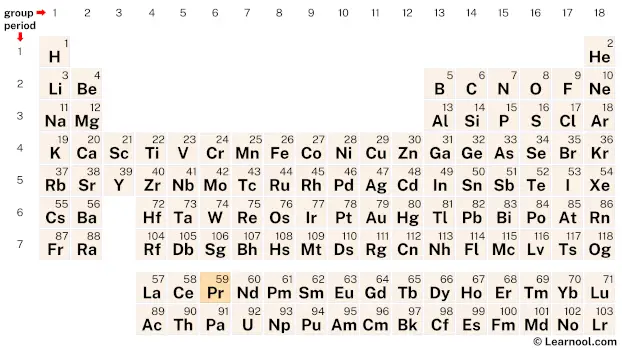 |
|
| Origin of name | Greek word “prasios didymos” (which means green twin) |
| Symbol | Pr |
| Atomic number (Z) | 59 |
| Atomic mass | 140.90765 u |
| Block | f-block |
| Period | 6 |
| Classification | Lanthanide |
| Atomic radius | 182 pm |
| Covalent radius | 203±7 pm |
| Melting point | 935 ℃, 1715 ℉, 1208 K |
| Boiling point | 3130 ℃, 5666 ℉, 3403 K |
| Electron configuration | [Xe] 4f3 6s2 |
| Electrons per shell | 2, 8, 18, 21, 8, 2 |
| Learn how to draw: Praseodymium Bohr model | |
| Crystal structure | Double hexagonal close-packed (dhcp) |
| Phase at r.t | Solid |
| Density near r.t | 6.77 g/cm3 |
| Main isotopes | Praseodymium-141 |
| Natural occurrence | Primordial |
| Oxidation state | +3 |
| Electronegativity (Pauling scale) | 1.13 |
| Protons Neutrons Electrons |
59 82 59 |
| CAS number | 7440-10-0 |
| Discovered by | Carl Auer von Welsbach in 1885 |
History
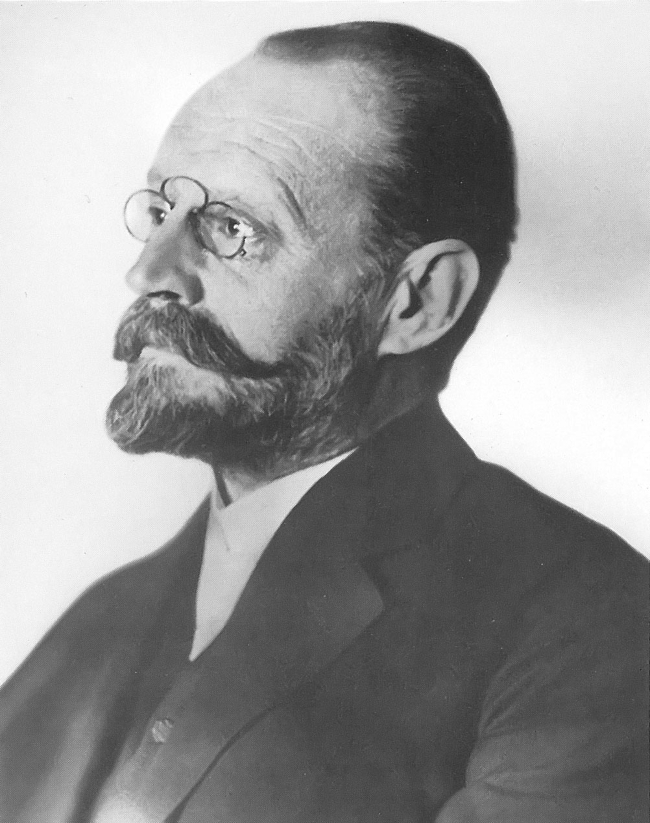
Praseodymium was discovered by Carl Auer von Welsbach, an Austrian chemist, in 1885. He extracted it from a material called didymium, which was believed to be a new element at the time. It was later discovered that didymium was actually a mixture of two elements, praseodymium and neodymium.
Praseodymium was named after the Greek words “prasios” meaning green, and “didymos” meaning twin, due to the green lines in its spectrum that were similar to those of neodymium. The discovery of praseodymium, along with neodymium, helped to complete the rare earth series of elements.
Occurrence and production
Praseodymium is a relatively abundant rare earth element and is found in several minerals including monazite, bastnasite, and xenotime. Monazite sand, which is primarily composed of the rare earth elements, is a significant commercial source of praseodymium. Bastnasite and xenotime are also mined for their rare earth element content.
Praseodymium is primarily produced through a process called solvent extraction, which involves dissolving rare earth minerals in acid and then separating the individual elements using various chemical techniques. The most common method for extracting praseodymium involves a series of solvent extractions and ion exchange processes.
Properties
Praseodymium is a soft, silvery-white metal that is highly reactive and can quickly tarnish in air.
It has a hexagonal close-packed crystal structure and is paramagnetic at room temperature.
Praseodymium has a density of 6.77 g/cm3 and it has a relatively high melting point of 935 ℃ and a boiling point of 3130 ℃.
Praseodymium is a member of the lanthanide series and has an electron configuration of [Xe] 4f3 6s2.
It exhibits paramagnetism, meaning that it is weakly attracted to magnetic fields.
Praseodymium has a relatively high thermal neutron capture cross-section, making it useful for neutron-absorbing applications.
It is a good conductor of electricity and has a molar heat capacity of 27.2 J/mol·K.
Praseodymium is a rare earth element, and as such, it has similar chemical and physical properties to other rare earth elements.
Its ionic radius is similar to that of calcium, and it forms a wide range of oxidation states from +2 to +4.
Applications
Magnets
Praseodymium is used in the production of high-strength magnets, particularly in combination with neodymium and other rare earth elements. These magnets are used in a wide variety of applications, including in electric vehicles, wind turbines, and computer hard drives.
Glass and ceramics
Praseodymium oxide is used as a colorant in glass and ceramics, producing a unique yellow-green color. It is also used in the production of specialized glass fibers for use in communication networks.
Lighting
Praseodymium is used in certain types of lighting, including incandescent and fluorescent bulbs. It is also used as a phosphor in some types of LEDs, helping to produce a range of colors.
Catalysts
Praseodymium is used as a catalyst in some chemical reactions, particularly in the production of certain plastics and synthetic rubbers. It can also be used in the refining of petroleum and other fuels.
Medicine
Praseodymium isotopes are used in radiation therapy for the treatment of cancer, as well as in bone scans and other diagnostic tests. Additionally, praseodymium compounds have shown potential for use in some anticancer drugs.
Metallurgy
Praseodymium is used in some specialized alloys, including those used in aircraft engines and other high-performance applications. It is also used as a doping agent in some semiconductors and other electronic materials.
Interesting facts
Praseodymium is a rare earth element that is silvery-white in color and relatively soft. The element was named after the Greek words “prasios” and “didymos”, which mean “green twin”.
Praseodymium is used in alloys with magnesium to create high-strength metals that are used in aircraft engines and other applications.
It is also used in the production of certain types of glass, such as those used in the lenses of cameras and other optical equipment.
Praseodymium has been used in recent years to create high-performance magnets, which are used in wind turbines, electric motors, and other applications.
It has a relatively low level of radioactivity and is not considered to be hazardous to human health in normal use.
Praseodymium has a number of isotopes, some of which have been used in medical imaging and other applications.
It is one of the more abundant rare earth elements and is found in a number of minerals, including monazite and bastnäsite.
Praseodymium has been used in recent years to develop new types of lighting, such as energy-efficient lamps and LED lights.
It has potential uses in nuclear reactors, as it has a high neutron-capture cross-section and can be used to control the rate of nuclear reactions.
Related
More elements
External links
- https://www.rsc.org/periodic-table/element/59/praseodymium
- https://en.wikipedia.org/wiki/Praseodymium
- https://www.britannica.com/science/praseodymium
- https://www.chemicool.com/elements/praseodymium.html
- https://pubchem.ncbi.nlm.nih.gov/element/Praseodymium
- https://www.thoughtco.com/praseodymium-facts-element-59-4125194
- https://www.livescience.com/37655-praseodymium.html
Deep
Learnool.com was founded by Deep Rana, who is a mechanical engineer by profession and a blogger by passion. He has a good conceptual knowledge on different educational topics and he provides the same on this website. He loves to learn something new everyday and believes that the best utilization of free time is developing a new skill.
